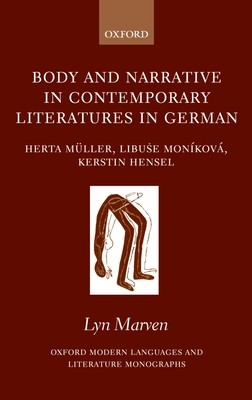
- We will send in 10–14 business days.
- Author: Lyn Marven
- Publisher: Clarendon Press
- ISBN-10: 0199277761
- ISBN-13: 9780199277766
- Format: 14 x 21.6 x 2.1 cm, hardcover
- Language: English
- SAVE -10% with code: EXTRA
Body and Narrative in Contemporary Literatures in German (e-book) (used book) | bookbook.eu
Reviews
Description
This book examines the relationship between representations of the body and narrative strategies in the work of three contemporary women writers from the former Eastern Bloc countries: Herta Müller, an ethnic German from Romania; Libuse MonÃková, who emigrated from Czechoslovakia to West Germany and chose to write in German; and Kerstin Hensel, from the GDR.
Marven shows how the content and form of their works are interlinked, and how these challenge the hegemonic discourses within repressive socialist regimes. The introduction contextualizes the writers' socially, culturally, and historically, and outlines the theoretical basis of the approach, drawing on psychoanalysis, performativity theory, and feminist critical theory. Chapters on the individual authors offer new interpretations of the writers' works, focusing on the structures of trauma (in Müller's work), hysteria (in MonÃková's) and the grotesque (in Hensel's). The images of the body analyzed in the first half of each chapter show the effects of violence; challenge the understanding of the body as natural or authentic; and raise questions about identity and gender. The analysis in the second half of each chapter covers a range of formal features, from the fantastic and collage, through parody and intertextuality, to irony, plot, and story telling. The book also traces developmentsin the work of all three authors, taking account of the historical changes in the Eastern Bloc countries since 1989. Body and Narrative in Contemporary Literatures in German will be valuable for anyone researching contemporary German literatures, as well as those interested in feminist theory, minority literatures, and trauma.
EXTRA 10 % discount with code: EXTRA
The promotion ends in 20d.18:24:20
The discount code is valid when purchasing from 10 €. Discounts do not stack.
- Author: Lyn Marven
- Publisher: Clarendon Press
- ISBN-10: 0199277761
- ISBN-13: 9780199277766
- Format: 14 x 21.6 x 2.1 cm, hardcover
- Language: English English
This book examines the relationship between representations of the body and narrative strategies in the work of three contemporary women writers from the former Eastern Bloc countries: Herta Müller, an ethnic German from Romania; Libuse MonÃková, who emigrated from Czechoslovakia to West Germany and chose to write in German; and Kerstin Hensel, from the GDR.
Marven shows how the content and form of their works are interlinked, and how these challenge the hegemonic discourses within repressive socialist regimes. The introduction contextualizes the writers' socially, culturally, and historically, and outlines the theoretical basis of the approach, drawing on psychoanalysis, performativity theory, and feminist critical theory. Chapters on the individual authors offer new interpretations of the writers' works, focusing on the structures of trauma (in Müller's work), hysteria (in MonÃková's) and the grotesque (in Hensel's). The images of the body analyzed in the first half of each chapter show the effects of violence; challenge the understanding of the body as natural or authentic; and raise questions about identity and gender. The analysis in the second half of each chapter covers a range of formal features, from the fantastic and collage, through parody and intertextuality, to irony, plot, and story telling. The book also traces developmentsin the work of all three authors, taking account of the historical changes in the Eastern Bloc countries since 1989. Body and Narrative in Contemporary Literatures in German will be valuable for anyone researching contemporary German literatures, as well as those interested in feminist theory, minority literatures, and trauma.


Reviews